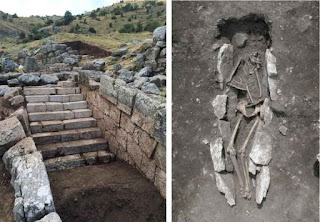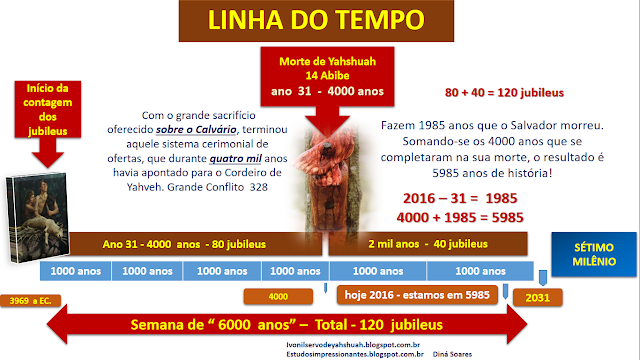By Grace E. Amadon
From the archives of Andrews University
Center for Adventist Research
Grace Amadon Collection
Box 2; Folder 4
The Millerite argument, with its epochal conclusion, was based upon standard contemporary almanac tables of the moon, together with sound Jewish calendation. This involved rejection of the current Rabbinical calendar with its erroneous Day of Atonement, and a return to the basic principle of Mosaic calendation. The vital steps, taken progressively are as follows:
1. Confronted by rival Jewish calendars (the rabbanite and the Karaite), the Millerites deliberately rejected the rabbinical and adopted the Karaite principle of calendation, the decisive factor being the barley harvest principle in relation to the Passover full moon, as embodied in the original Mosaic instruction.
2. Confronted by the rival Passovers of the respective calendars, (the Rabbinical April 3 or the Karaite, May 2) the Millerites rightly rejected the rabbinical April 3 as Nisan 14 and chose instead May 2 s conforming to the barley harvest stipulation for the true Nisan 14 in 1844.
3. Computing the true ending of the Jewish sacred year “1844,” [sic] and the beginning of “1844” on the basis of the now adopted Karaite calendar principle, they terminated the Jewish year “1843” at sunset on April 18 (of the civil year 1844), instead of on Miller’s original March 21, which he had based on rabbinical calendar practice.
4. April 19 was then taken to be the civil date, equivalent of the true Nisan 1, for the sacred Jewish year “1844” in contrast to the rabbinical new year’s day.
5. The Nisan new moon in 1844, could not be seen on the evening of April 17 (the day of conjunction), for the required translation period time was too short. Nor could the phases, or appearance, be delayed to the sunset of April 19, as the moon could be seen in Boston on the evening of April 18, for an hour and a half after sunset. This was therefore, chosen the sunset beginning of the Jewish New Year’s day (April 18/19), which sets the entire series of Jewish feast dates.
Note: The Millerites chose the Nisan 1 date chiefly by this simple rule: That the moon’s phases “usually appeared the second evening after its change.” This was precisely the case at the time of the Ve-Adar conjunction, April 17 11h 45m (that is .49), in 1844 – or at approximately noon. The time from that noon to sunset – only about six hours – was entirely too short for the moon to be seen that first evening after conjunction. Consequently, the moon’s first appearance in Boston, could not possibly occur on the evening of April 17. But on April 18, the sun set at 6:37 P.M. in Boston, and the moon at 8:03 P.M. The young moon was therefore high above the horizon in the northern sky for nearly an hour and a half after sunset. Moreover, the calendrical limits of the year and the month forbade choosing an April 19 phases as a day too late. Consequently, the evening of April 18 constituted the required date for the moon’s pre-Nisan phases in 1844, and Nisan 1 followed as April 19 according to abundant Millerite records.
6. The Millerites then “reckoned” Tisri 1 (first day of the Jewish seventh month) for 1844, by adding six lunar months (6 X 29½, or 177 days), to Nisan 1 (April 19), which gave October 13 as the civil equivalent of the true Tisri 1.
7. As October 13 was Tisri 1, October 22 was therefore fixed upon as the fateful Tisri 10. (A few erroneously added ten additional days to October 13, and thereby obtained October 23 – failing to recognize that October 13 was itself the first day of Tisri, and consequently but nine days were to be added to bring the tenth. The general position of the movement, however, was definitely for October 22.)
8. The foregoing “tenth-day-of-the-seventh-month-movement” position, for October 22, was generally accepted during and immediately following, the
memorable Exeter meeting in the middle of August, 1844, over two months prior to October 22.
9. Had the leaders waited until October to visually observe the first appearance of the moon by which to date Tisri 1, there could have been no seventh month movement, for there would have been insufficient time. They had to make their calculation in advance from standard moon tables which were abundantly available. The Tisri date had to be computed from the indisputable basis of the Nisan translation period, that could not be mistaken or shifted. Moreover, had they waited until October, the Tisri phasis could not have been seen so far north as Boston, for the moon was far south of the celestial equator, and was observable only in the central west and the extreme south of this land of the seventh month movement. That the Tisri dating was computed from the Nisan 1 date of April 19 is the clear declaration of the Millerites in their official report in January, 1845, as they reviewed and reaffirmed the technical soundness of the seventh month movement position on the crucial date of October 22:
“Reckoning from this [Nisan] moon, the seventh Jewish month commenced with the appearance of the moon on the 13th of October; so that the tenth day of the seventh month synchronized with the 22d of that month.” –Bliss, The Advent Shield, January, 1845, p. 278. [Italics inserted by G. Amadon.]
“It is therefore evident that the seventh month must have commenced with the new moon in October; and that the tenth day of the seventh month of the Jewish Sacred year, in A. D. 1844, could only synchronize with the 22d of that month.” – Idem., p. 279.
All underline in original document.
4angelspublications.com/amadon.php
pesquisado por
Diná Soares
From the archives of Andrews University
Center for Adventist Research
Grace Amadon Collection
Box 2; Folder 4
The Millerite argument, with its epochal conclusion, was based upon standard contemporary almanac tables of the moon, together with sound Jewish calendation. This involved rejection of the current Rabbinical calendar with its erroneous Day of Atonement, and a return to the basic principle of Mosaic calendation. The vital steps, taken progressively are as follows:
1. Confronted by rival Jewish calendars (the rabbanite and the Karaite), the Millerites deliberately rejected the rabbinical and adopted the Karaite principle of calendation, the decisive factor being the barley harvest principle in relation to the Passover full moon, as embodied in the original Mosaic instruction.
2. Confronted by the rival Passovers of the respective calendars, (the Rabbinical April 3 or the Karaite, May 2) the Millerites rightly rejected the rabbinical April 3 as Nisan 14 and chose instead May 2 s conforming to the barley harvest stipulation for the true Nisan 14 in 1844.
3. Computing the true ending of the Jewish sacred year “1844,” [sic] and the beginning of “1844” on the basis of the now adopted Karaite calendar principle, they terminated the Jewish year “1843” at sunset on April 18 (of the civil year 1844), instead of on Miller’s original March 21, which he had based on rabbinical calendar practice.
4. April 19 was then taken to be the civil date, equivalent of the true Nisan 1, for the sacred Jewish year “1844” in contrast to the rabbinical new year’s day.
5. The Nisan new moon in 1844, could not be seen on the evening of April 17 (the day of conjunction), for the required translation period time was too short. Nor could the phases, or appearance, be delayed to the sunset of April 19, as the moon could be seen in Boston on the evening of April 18, for an hour and a half after sunset. This was therefore, chosen the sunset beginning of the Jewish New Year’s day (April 18/19), which sets the entire series of Jewish feast dates.
Note: The Millerites chose the Nisan 1 date chiefly by this simple rule: That the moon’s phases “usually appeared the second evening after its change.” This was precisely the case at the time of the Ve-Adar conjunction, April 17 11h 45m (that is .49), in 1844 – or at approximately noon. The time from that noon to sunset – only about six hours – was entirely too short for the moon to be seen that first evening after conjunction. Consequently, the moon’s first appearance in Boston, could not possibly occur on the evening of April 17. But on April 18, the sun set at 6:37 P.M. in Boston, and the moon at 8:03 P.M. The young moon was therefore high above the horizon in the northern sky for nearly an hour and a half after sunset. Moreover, the calendrical limits of the year and the month forbade choosing an April 19 phases as a day too late. Consequently, the evening of April 18 constituted the required date for the moon’s pre-Nisan phases in 1844, and Nisan 1 followed as April 19 according to abundant Millerite records.
6. The Millerites then “reckoned” Tisri 1 (first day of the Jewish seventh month) for 1844, by adding six lunar months (6 X 29½, or 177 days), to Nisan 1 (April 19), which gave October 13 as the civil equivalent of the true Tisri 1.
7. As October 13 was Tisri 1, October 22 was therefore fixed upon as the fateful Tisri 10. (A few erroneously added ten additional days to October 13, and thereby obtained October 23 – failing to recognize that October 13 was itself the first day of Tisri, and consequently but nine days were to be added to bring the tenth. The general position of the movement, however, was definitely for October 22.)
8. The foregoing “tenth-day-of-the-seventh-month-movement” position, for October 22, was generally accepted during and immediately following, the
memorable Exeter meeting in the middle of August, 1844, over two months prior to October 22.
9. Had the leaders waited until October to visually observe the first appearance of the moon by which to date Tisri 1, there could have been no seventh month movement, for there would have been insufficient time. They had to make their calculation in advance from standard moon tables which were abundantly available. The Tisri date had to be computed from the indisputable basis of the Nisan translation period, that could not be mistaken or shifted. Moreover, had they waited until October, the Tisri phasis could not have been seen so far north as Boston, for the moon was far south of the celestial equator, and was observable only in the central west and the extreme south of this land of the seventh month movement. That the Tisri dating was computed from the Nisan 1 date of April 19 is the clear declaration of the Millerites in their official report in January, 1845, as they reviewed and reaffirmed the technical soundness of the seventh month movement position on the crucial date of October 22:
“Reckoning from this [Nisan] moon, the seventh Jewish month commenced with the appearance of the moon on the 13th of October; so that the tenth day of the seventh month synchronized with the 22d of that month.” –Bliss, The Advent Shield, January, 1845, p. 278. [Italics inserted by G. Amadon.]
“It is therefore evident that the seventh month must have commenced with the new moon in October; and that the tenth day of the seventh month of the Jewish Sacred year, in A. D. 1844, could only synchronize with the 22d of that month.” – Idem., p. 279.
All underline in original document.
4angelspublications.com/amadon.php
pesquisado por
Diná Soares










Comentários
Postar um comentário